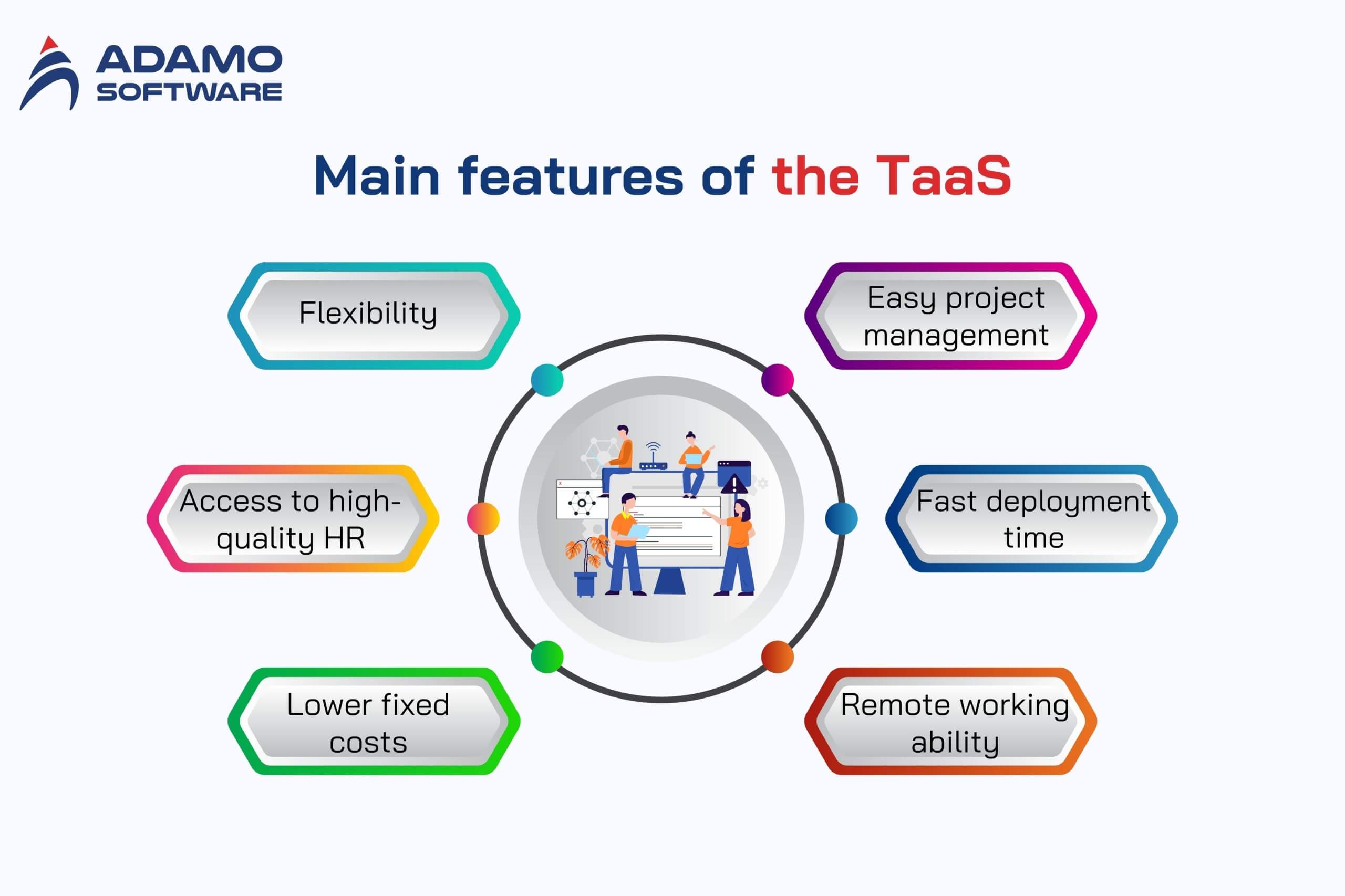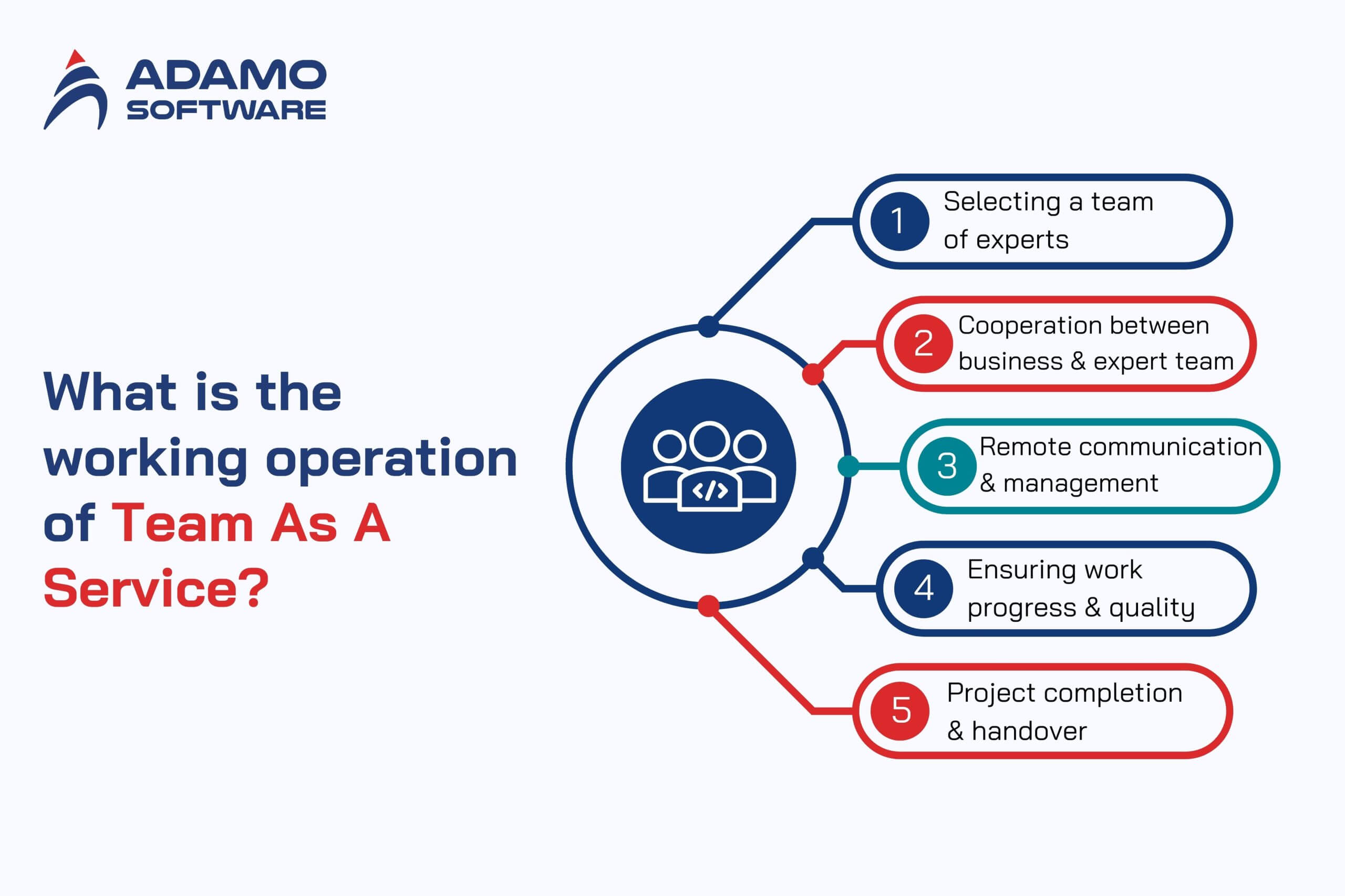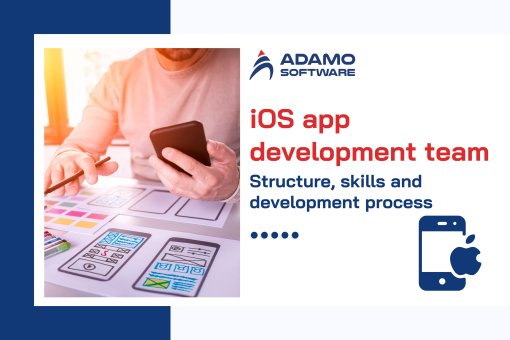Team as a service (TaaS): Full guide about this modern hiring model

In today’s fast-paced world, businesses do not rely only on traditional channels to recruit employees. The Team as a Service (TaaS) is a modern recruitment model that more companies are using for its benefits. Instead of recruiting permanent staff, businesses can hire a whole team of experts for specific projects or tasks using the TaaS model. Compared to traditional full-time recruitment, this model is more flexible, economical, and has quick access to global talents, without having to worry about legal constraints or complex human resource management. Let’s learn about this modern hiring model with Adamo Software!
Through this blog post, you will know the definition of the Team as a Service, and the working operation of TaaS. Besides, this blog post also discusses the structure of the TaaS and the cost of hiring a TaaS team. All information has been carefully researched and updated to the latest trends. So, let’s read our blog post and find yourself some useful information!
I. What is Team as a Service?
The Team as a Service is a modern model that allows businesses to outsource outside experts to conduct specific projects instead of permanent staff. This model is outstanding with its flexibility and customizability, which helps organizations expand or reduce group size based on actual needs. TaaS is typically provided by service-focused companies, which include experts in a variety of fields such as software development, marketing, finance, and many other industries. Adamo Software is among the choices of service providers.
Using the Team as a service, businesses can save long-term human resource management costs and optimize operational efficiency. Below are some outstanding features of the TaaS.

- Flexibility
Thanks to the flexibility, TaaS enables firms to easily adjust the size of the team based on project requirements. When the project ends, organizations can terminate the contract with the group and stop the service without any long-term commitment. This is one of the differences between TaaS and traditional recruitment, which requires businesses to guarantee long-term employment for employees. Besides, for long-term traditional recruitment, the process of laying off and recruiting additional staff for the team will be more complicated.
- Access to high-quality human resources
Instead of hiring individuals with the steps of selection, interviewing, and training, the Team as a Service helps businesses select a team of experts to complete the tasks or projects. These experts often have a profound background, knowledge, and experience in the industry, helping businesses save time in launching projects.
- Lower fixed costs
With the TaaS model, businesses can lower the fixed costs of salaries, insurance, and long-term benefits for employees. Instead, they just have to pay for the group who work during the specific project time. This helps optimize budgets, especially when the project is temporary and does not require full-time staff.
- Easy project management
The Team as a Service helps organizations easily manage projects without worrying about internal human resources issues. Instead of having to directly manage employees, TaaS providers will help businesses monitor the work team, and ensure the progress and quality of work. This reduces businesses’ workloads, enabling them to focus on core business strategies.
- Fast deployment time
Thanks to the lean operating procedures, businesses can reduce the time deploying the projects. The TaaS group can join the project immediately. This streamlined process helps businesses initiate and execute projects quickly, minimizing preparation time and optimizing development phases. Thereby, they can shorten the time to market for products or services, increase competitiveness, and meet customer needs in a timely manner.
- Remote working ability
Team as a Service enables teams to work remotely. With this model, businesses can access a global workforce and take advantage of the diversity of skills and expertise. Remote working also helps businesses reduce office and infrastructure costs while increasing flexibility in project coordination.
In general, the Team as a Service is a flexible recruitment model that allows businesses to hire outside experts to carry out specific projects instead of permanent employees. For more insights about the working operation of TaaS, let’s keep reading the next section of our blog post.
Also read: Advantages of team as a service: Why not just use own in-house team?
II. What is the working operation of Team as a service?
As mentioned, the Team as a Service model brings many benefits for businesses regarding costs, time, and the ability to access global talents. But how does it work to help firms optimize their project implementation? Let’s find out the answer with Adamo Software.mm Here’s the working operation of the TaaS.

1. Selecting a team of experts
In the Team as a Service model, businesses do not need to directly hire each employee but can hire a team of experts selected from the service provider. Businesses must identify the requirements and goals of the projects so that the service providers can help them choose a suitable expert group. This team usually includes experts with skills that match the specific requirements of the project and have experience working together, helping to optimize work performance. With the model, businesses can save time and effort in the recruitment process and optimize work performance.
2. Flexible cooperation between business and expert team
The Team as a Service model creates flexible cooperation between the business and expert teams. Businesses can hire the TaaS team for a short-term project or long-term for ongoing development goals. When businesses change their requirements, the service providers can quickly adjust the size and structure of the team to meet new requirements without disrupting the workflow. This flexibility helps businesses save costs and adapt to the market and customer needs. Besides, organizations can experiment with different teams to find the most effective structure and collaboration, optimizing the final results of the project.
3. Remote communication and management
Remote communication and management play an important role in ensuring effective collaboration between businesses and expert teams. The Team as a Service model uses digital tools to maintain constant contact. These tools include project management software, chat apps, online meeting platforms, etc. Thanks to these tools, businesses and experts can easily update progress, exchange ideas, and resolve problems promptly.
Effective communication creates a favorable condition for innovation and creativity in work. By establishing regular meetings and clear communication channels, businesses can track project progress. Besides, they can ensure that the Team as a Service is working according to the company’s goals. This helps to improve productivity and build a strong and trusting working relationship between both parties.
4. Ensuring work progress and quality
One of the strengths of TaaS is that the service provider is primarily responsible for managing the work team, including ensuring work progress and quality. By setting clear standards and specific goals, the TaaS team can focus on completing tasks on time while ensuring high quality. Businesses will only need to focus on evaluating results and adjusting project goals.
Additionally, businesses can identify potential issues early thanks to regular monitoring and evaluation of work results. From this, they can make timely adjustments to keep the project on track. Regular reports and progress meetings are important tools in maintaining transparency and accountability within the team.
5. Project completion and handover
In the Team as a Service model, the project completion and handover process take place in a systematic and professional manner. When the project is coming to an end, the TaaS team will compile and finalize all the work that has been done. The team must ensure that all requirements and quality criteria have been met. The service provider will perform final checks to ensure that the product or service meets standards before handing it over to the business.
After finishing the project, the TaaS team will hand over all documentation, reports, and work results to the business. This includes providing user manuals, technical documentation, and any information necessary for the business to continue working on the project independently.
Once completed, businesses can decide whether to continue using the TaaS model to work again with the current team for their next work. In addition, they can also choose to end the contract with the team without any obligations. This process not only ensures that the business receives the best results, but also helps to strengthen the relationship between the business and the service provider for future opportunities.
In general, the Team as a Service model provides a flexible and effective approach to human resource management for businesses. With a tightly organized operating process, TaaS helps businesses save time, costs and optimize work performance. In the next part of this blog post, you will find more detailed information about the Team as a service structure.
III. What is a Team as a service structure?
The Team as a Service structure encompasses many specific roles such as project managers, developers, UX/UI designers, and testing specialists. Each member takes on a specific task, which increases efficiency and coordination within the team. This allows the team to flexibly scale in size and skill set according to the needs of the project, ensuring that the business can meet goals and requirements quickly. Here are some groups that can contribute to the businesses’ projects.

1. Project managers
Project managers play a key role in the Team as a Service, responsible for planning, arranging, and monitoring the project’s progress. They must ensure that the team and the client can clearly communicate information and requirements. Additionally, project managers address issues as they arise, helping teams maintain high performance and remain flexible in the face of change.
Thanks to the understanding of processes and the ability to coordinate multiple stakeholders, project managers can ensure that the projects are completed on time and meet the established quality standards. With the guidance of the project manager, the TaaS team can maximize their capabilities, bringing the best results for the business.
2. Front-end developers
Front-end developers in the Team as a Service model are responsible for building and optimizing the user interface of the web app or mobile app. They must ensure the smoothness of all components that the user interacts with. They may use programming languages like HTML, CSS, and JavaScript to develop visual interfaces. Additionally, front-end developers also optimize the application to ensure good performance across different devices and platforms. By handling the complexities of interfaces and interactions, front-end developers play a vital role in enhancing the end-user experience and contributing to the success of the project.
3. Back-end developers
In the Team as a Service model, back-end developers help to develop and maintain the back end of applications. They include databases, servers, and system logic. Back-end developers must ensure that data is processed correctly and interacts efficiently with the front-end. By using Python, Java, Node.js, etc., back-end developers build complex APIs and data management systems that support the core functionality of the application and ensure it operates stably and securely.
4. DevOps Engineers
DevOps engineers in teams as a service play an important role in managing, automating, and optimizing the software development process. They must integrate development and operations, helping to ensure that systems can be deployed continuously, quickly, and efficiently. DevOps engineers use automation tools to improve performance, minimize failures, and maximize the stability of production environments, while ensuring the security and scalability of systems.
5. Business Analyst
Business Analysts in Team as a Service connect the business and the development team. They are responsible for analyzing customer requirements, defining project goals and success criteria. Business Analysts then communicate these requirements to the development team in a concrete form, helping to ensure that the final product is in line with business expectations.
IV. How much does it cost to hire a TaaS team?
The cost to hire a TaaS team can be changeable depending on different factors, such as the project scale, team expertise requirements, and collaboration time. Besides, the number of experts in the Team as a service group, the level of complexity, and the geographic location of the service provider also affect the costs. Let’s look at each factor with Adamo Software!
1. The number of experts in a team
Depending on the number of experts and their expertise, the costs for recruiting the Team as a Service group can fluctuate. Here are some reference prices.
- Small group (2-3 people): The costs range from USD 5,000 to USD 15,000/ month, depending on the role such as project manager or developer.
- Medium team (4-6 people): The price can range from USD 15,000 to USD 30,000/ month, including experts from development, testing to design.
- Large group (from 7 members): The cost can be over USD 30,000/ month, especially for projects that require complex technologies or high expertise.
2. Team expertise requirements
The cost to hire a TaaS team also depends on the project’s expertise requirements. Businesses can refer to these expertise-based cost levels below to deal with the service providers.
- Common technologies (Web Development, Mobile Development): Prices range from $5,000 to $20,000/ month, depending on the complexity and detailed requirements.
- Advanced technologies (Blockchain, AI, Machine Learning): Costs are higher, typically $20,000 to $50,000/ month, due to the requirement for experts with deep experience and specialized knowledge.
These costs will vary based on the complexity and skills required in the project.
3. Cooperation time
The cost of hiring a Team as a Service team is also affected by the length of the engagement. Below are some specific pricings based on this factor.
- Short-term engagements (1-3 months): Typically cost more due to rapid deployment and turnaround times, ranging from $7,000 to $25,000/ month depending on team size and expertise.
- Long-term engagements (6 months or more): Costs can be reduced due to stability, ranging from $5,000 to $20,000/ month, and often have more favorable terms for longer engagements.
These numbers are estimates only and may vary by project.
4. Geographic location of the service providers
The cost of hiring a TaaS team from countries with high standards of living like the US, Canada, or Western Europe is often higher than from countries with lower labor costs, like Southeast Asia or Eastern Europe. The reference costs are as below.
- US, Canada, Western Europe: High cost, usually from 20,000 to 50,000 USD/month due to higher living standards and salaries of employees in these regions.
- Eastern Europe, South Asia: Cheaper, around 10,000 to 30,000 USD/month, but still ensures quality thanks to a highly skilled and qualified team.
- Southeast Asia (Vietnam, Philippines, India): Lower cost, ranging from 5,000 to 20,000 USD/month with stability and competitiveness in quality.
Overall, based on the above factors, businesses can choose the appropriate Team as a Service hiring package to optimize costs and flexibly meet project requirements.
V. Adamo Software – The leading outsourcing software development in Vietnam

Are you looking for a reliable TaaS service provider that can help you with your software development? If yes, Adamo Software can be your ideal choice. As one of Vietnam’s leading companies in technology and software outsourcing, Adamo Software lets you hire a dedicated development team. With experienced experts in many fields, Adamo is committed to providing flexible customized development groups according to the requirements of each project. Here are some outstanding features of Adamo’s Team as a Service team.
- Highly specialized team
- Flexible customization
- Cost savings
- Easy management
- Security and safety
- Fast deployment time
Still hesitate whether to choose Adamo Software? Let’s contact our team and we will answer all your questions.











